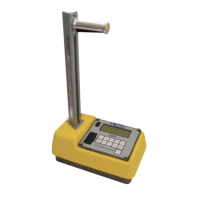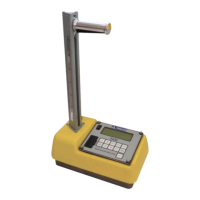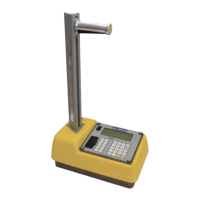DENSITY
The Troxler Model 3430 gauge utilizes two modes of operation:
direct transmission mode (source rod extended into the material)
and backscatter mode. Figures 2-1 and 2-2 illustrate the two modes
of operation.
In direct transmission mode (Figure 2-1), the rod containing the
cesium-137 (8 mCi/0.3 GBq) source is lowered to the desired depth.
The detectors (G-M tubes) in the gauge base measure the radiation
emitted by the source rod. Gamma photons reaching the detectors
must first pass through the material, colliding with electrons present
in the material. In general, the lower the number of photons that
reach the detectors, the higher the material density.
In backscatter mode (Figure 2-2), the gamma photons that enter the
material must be scattered (or reflected) at least once to reach the
detectors in the gauge. With the rod locked in the first notch below
the SAFE position, the source and detectors are in the same plane,
referred to as the backscatter position. Photons emitted from the
source penetrate the material, and the detectors measure the
scattered photons. Shielding between the source and detectors
greatly reduces the number of photons reaching the detectors in a
direct path with the source.
While the direct transmission geometry measures the average
density of the material from the source to the surface, the
backscatter geometry yields an average heavily weighted by the
density close to the surface. Figure 2-3 shows two normalized top
layer effect curves, illustrating the percentages of photons at the
detectors for various depths. The two curves can be used to compute
the gauge response to layered material of different densities. For
example, the density of the top inch of a surface layer accounts for
approximately 52% of the backscatter density measurement.

